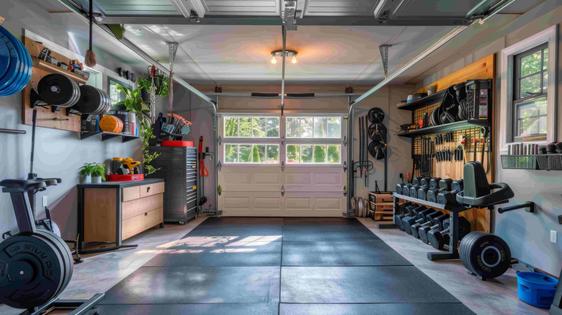Home Gym Barbells: How To Build Strength Without Leaving the House
Published in Health Articles
For those looking to skip the gym’s hustle—packed spaces, rigid schedules, endless membership fees—a home gym is the perfect answer. And with a barbell, , there’s no limit to the power you can build at home. Training with barbells at home hands you the reins, letting you work out whenever you want. But it’s not always smooth sailing. That’s where this guide steps in. It’s packed with straightforward tips and easy-to-follow steps, all aimed at helping anyone create a barbell routine that gets real results without leaving the house. Read on.
Benefits of Using Barbells at Home
Transforming your fitness routine with a home gym brings freedom and flexibility, and adding home gym barbells is key to making it truly effective. Here’s why they’re worth the investment:
Efficient Full-Body Workouts
With compound exercises like squats, deadlifts, and presses, barbells target multiple muscle groups at once, which is a huge plus for anyone short on time.
Convenience and Flexibility
Working out at home with barbells means no more planning trips to the gym or worrying about gym hours. Your equipment is always within reach, letting you squeeze in workouts whenever your schedule allows.
Cost-Effectiveness in the Long Run
in barbells for a home gym may seem like a big upfront cost, but it pays off over time. Gym memberships, with monthly fees that add up quickly, don’t give the same return on investment. Barbells, however, are durable and built to last, making them a budget-friendly choice for those looking to work out at home.
With home gym barbells, anyone can experience the benefits of a high-quality workout routine from the comfort of home. It’s an investment in convenience, health, and long-term strength that’s tough to beat.
Choosing the Right Barbell for Your Home Gym
Picking the best barbell is key, as it can impact both the range of exercises and the overall workout experience. Here’s a breakdown of what to consider when selecting a barbell that will complete your gym equipment setup.
Types of Barbells
Standard barbells are lighter, shorter, and hold less weight, making them ideal for beginners or tight spaces. An olympic barbell is longer, heavier, and handle more weight, perfect for advanced lifters and compatible with most plates, adding long-term versatility. Specialty weightlifting bars, like the EZ curl for arm exercises or the trap bar for deadlifts, offer unique grips suited to specific movements. Consider your workout needs to choose the best bar for your routine.
Weight Considerations
Standard barbell weight often hold around 100–200 pounds, which works well for lighter lifting or beginner workouts. Olympic barbells, by comparison, can handle upwards of 500 pounds and offer better durability for heavier lifts.
Space and Storage
your space is small, a shorter bar or even an adjustable dumbbell bar set might be more practical than a full-sized Olympic bar. Measure the area where you’ll be working out to ensure you have room for your barbell and any equipment like racks or benches. For storage, consider a wall-mounted rack for plates or a vertical barbell holder to keep everything organized.
Selecting the right barbell is a foundational step in building a home gym that meets your needs. By thinking through these considerations, you’ll choose a barbell that supports both your workouts and your space.
Essential Barbell Exercises for Building Strength
A well-rounded barbell routine covers all major muscle groups, promoting balanced strength and stability. Here are some key exercises you can incorporate in your routine:
Lower Body Exercises
Barbell squats, deadlifts, and lunges are essential for building lower body strength. Squats work the quads, glutes, hamstrings, and core by lowering the body until thighs are parallel to the floor, then pressing back up. Deadlifts target the entire posterior chain—hamstrings, glutes, and lower back—by lifting the barbell from the ground with a flat back and strong hips. Barbell lunges add a stability element, engaging the core as you step forward and lower, then push back to standing.
Upper Body Exercises
The bench press, overhead press, and barbell rows are key for building upper body strength. The bench press works the chest, shoulders, and triceps by lowering the bar to the chest and pressing it back up. The overhead press targets shoulders, triceps, and upper chest by pushing the bar from shoulder height to overhead. Barbell rows strengthen the upper back, lats, and rear shoulders by pulling the barbell toward your torso with a flat back and elbows close.
Core and Stability Exercises
Barbell rollouts, landmine twists, and good mornings build core strength and stability. Rollouts involve rolling the barbell forward from your knees, extending the body while keeping the core tight. Landmine twists, with one end of the bar anchored, engage the obliques as you rotate the bar side to side. Good mornings strengthen the lower back and hamstrings by hinging forward with the barbell across the upper back, then returning to standing.
Adding these exercises to your routine builds balanced strength across major muscle groups, promoting both power and stability.
Creating an Effective Home Barbell Workout Routine
A well-planned routine enhances results and reduces the risk of injury and burnout. Here’s how to structure a balanced and effective barbell workout.
Warm-Up and Mobility Drills
Spend 5–10 minutes on light cardio, like jumping jacks or brisk walking, to increase blood flow. Follow with mobility drills, such as arm circles, leg swings, and hip openers, to improve flexibility and prep your muscles for the work ahead.
Structuring Your Workout
A structured workout ensures you’re training all major muscle groups evenly. Try a push-pull split, alternating between “push” exercises like squats and presses and “pull” exercises like deadlifts and rows. Another option is a full-body workout, covering lower body, upper body, and core in each session, three times a week.
Progression and Increasing Intensity
Gradually increase weight or reps as you improve, aiming for small, steady gains to prevent plateaus and keep motivation high.
With a solid warm-up, balanced structure, and gradual progression, your home barbell routine will keep you on track, even when you feel off your game, helping you build strength safely and consistently.
Final Thoughts
With the right barbell setup and a focused approach, a powerful and effective workout is always within reach at home. Now’s the time to create a space that fuels your fitness journey—step into your home gym and start building strength, one rep at a time.
























Comments